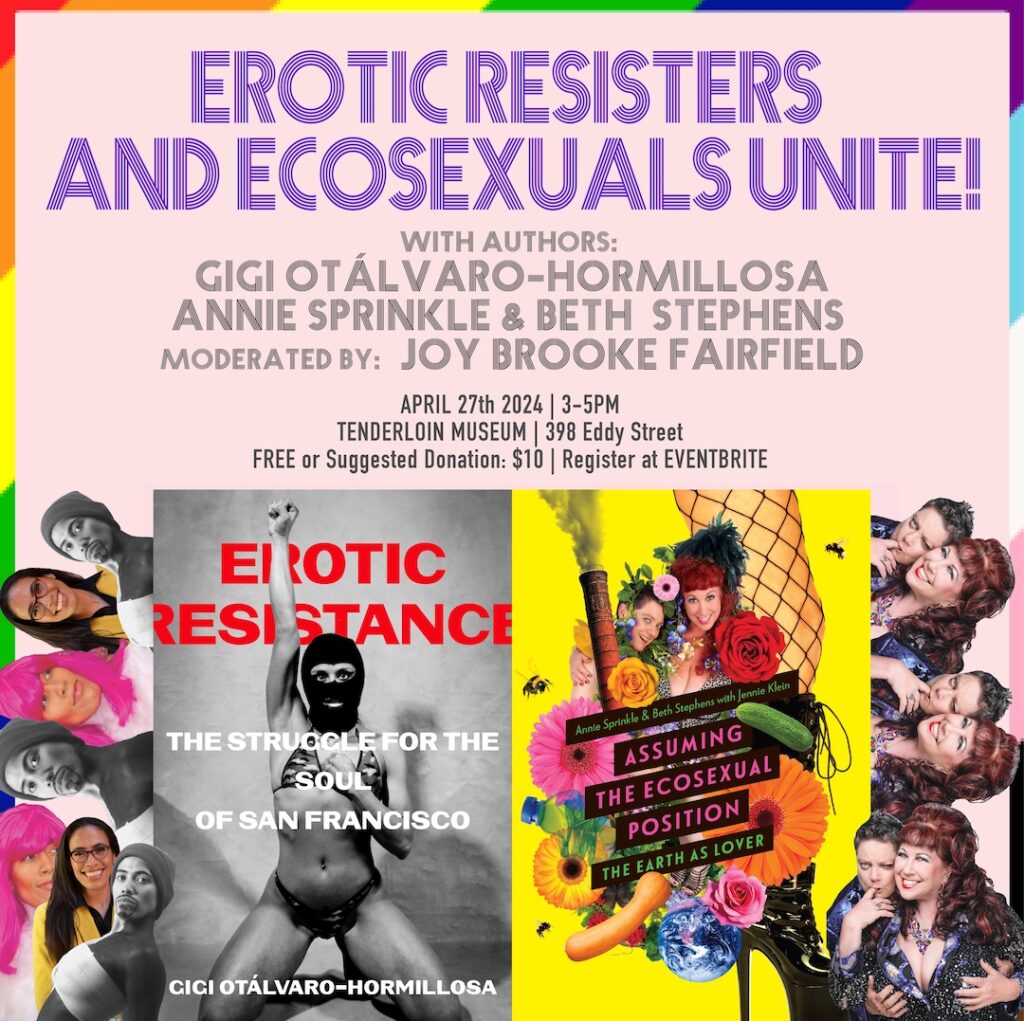
For purchasing options visit: University of California Press, Amazon, Barnes & Noble
30% discount when purchased on University of California Press website using code: UCPSAVE30
Erotic Resistance: The Struggle for the Soul of San Francisco (University of California Press, 2024) is an homage to the city and those who have grieved the loss of its unique character. The first dotcom boom and bust of the late 1990s evolved into the dominant cultural technocracy of the 2010s, which resulted in the dissipation of the city’s bohemian culture. Longtime San Franciscans, along with former residents and visitors who returned during these decades, equally commented on the accelerating, growing disappearance of the city’s character, which has repeatedly been articulated as its “soul.” Artists, writers, and activists alike have mourned and contributed to conversations about this loss, which I examine through the lens of eroticism. I have intentionally chosen to document erotic, and therefore deeply embodied performance cultures, because they have influenced the ethos of the city since the era of the Barbary Coast, which existed from the mid nineteenth century to the early twentieth century.

In the San Francisco herstories documented in this book, I cull from the perspectives of dancers, artists, and activists who performed in strip clubs, burlesque theaters, and in the performance and visual art scenes. My primary focus is on women who were active in these milieux from the 1960s through the 1990s, some of whom performed well into the twenty-first century. In this way, Erotic Resistance is an act of memory preservation regarding the city’s foundational role in the erotic entertainment and by extension, the sex industry in the United States. San Francisco historians have documented the earliest migrations of women to the city at its inception during the Gold Rush of the 1840s. The first women to arrive in the City by the Bay were prostitutes from other parts of the country, as well as Asia, Latin America, and Europe. While miners looked for gold, these women entrepreneurs followed suit, seeking to profit from the byproducts of the Gold Rush. Though often hidden from view in official narratives about the city, these pioneering women and the emergence of the sex industry are crucial components of the history of early San Francisco.
The tech boom of the early twenty-first century has often been described as a modern day manifestation of the Gold Rush; however, with the rise of technology and artificial intelligence, our embodied intelligence has diminished. As such, Erotic Resistance functions as a radical act and an invitation to return to the body at a time when human civilization’s disconnection from embodiment has reached its peak. Because of this, the project is also an act of erotic resistance to the complacency in, and celebration of, the dominant cultural technocracy. This phenomenon has been one of the primary contributing factors to gentrification and the city’s subsequent socioeconomic transformation which led to its cultural demise.
Erotic Resistance highlights the contributions of women of color, queer women, and trans women who were instrumental at key moments in the city’s history concerning the sex industry. In the 1960s, topless entertainment became legal in San Francisco for the first time in U.S. history, although cross-dressing continued to be criminalized. In yet another first instance in U.S. history, San Francisco artist-activist-dancers led successful class action lawsuits and efforts to unionize in the strip club industry in the 1990s. Using diverse methods including ethnography, visual and performance analysis, and historiography, I relate these phenomena through archival materials, artworks, and original interviews I conducted with women who performed in San Francisco’s burlesque scene and strip club industry during these time periods.
I analyze materials by and/or about the San Francisco dancers I interviewed through the lens of feminist queer performance theory. As such, the project troubles the boundary between “art” versus “pornography,” while seeking to open up the fraught relationship between “sex work” and “feminism.” The performances I examine took place in galleries, strip clubs, and on the street. As such, they call into question these key terms. Foregrounding the voices of these women performers, the book project resignifies stripper bodies in an effort to mitigate the stigma attached to their performances, and more broadly, to sex work. This challenge to “whorephobia” is relevant not just to sex workers, but to all women who express their sexuality explicitly or otherwise unconventionally, and are thus subject to archaic and patriarchal double standards.
In its earlier iteration as my doctoral dissertation titled Erotic Resistance: Performance, Art, and Activism in San Francisco Strip Clubs (1960s-2010s) completed in 2018 at Stanford University, the project received two awards: the inaugural Carl Weber Prize for Integration of Creative Practice & Scholarly Research from the Department of Theater and Performance Studies as well as the university-wide Graduate Feminist Scholar Award from the Office of the Vice Provost for Graduation Education and the Women’s Community Center. An article based on one of the chapters that covers the period between the 1960s to the 80s was published by University of California Press’s Latin American and Latinx Visual Culture in April of 2019. In February of 2020, this article, titled “Metamorphic and Sensuous Brown Bodies: Queer Latina/x Visual and Performance Cultures in San Francisco Strip Clubs, 1960s-1970s,” received the annual article award of the Association for Latin American Art, and was announced at the College Art Association Annual Conference which took place in Chicago that year.
Estimated publication date is March of 2024.
For a psychogeographic video related to the book project, see San Francisco Feelings: Sensual and Nostalgic Contemplations in the “Solo Projects” section.
For a related self-portrait, see Alchemy: Performing Myselves and the Everyday Practices of Subjectification/Objectification in the “Solo Projects” section.
